
The provenance of art in the world’s museums can paint a timeline of history as clearly as any book. Whenever I travel I visit museums, but my focus is less the artistic value of the art than the story its history of ownership tells about the region or country I am visiting.
Looking at the provenance of a single piece of art can take you through centuries, if not millennia, of conflicts, victors and economic shifts. The movement of art is history, military, political and economic, in miniature.
Gdansk, Poland
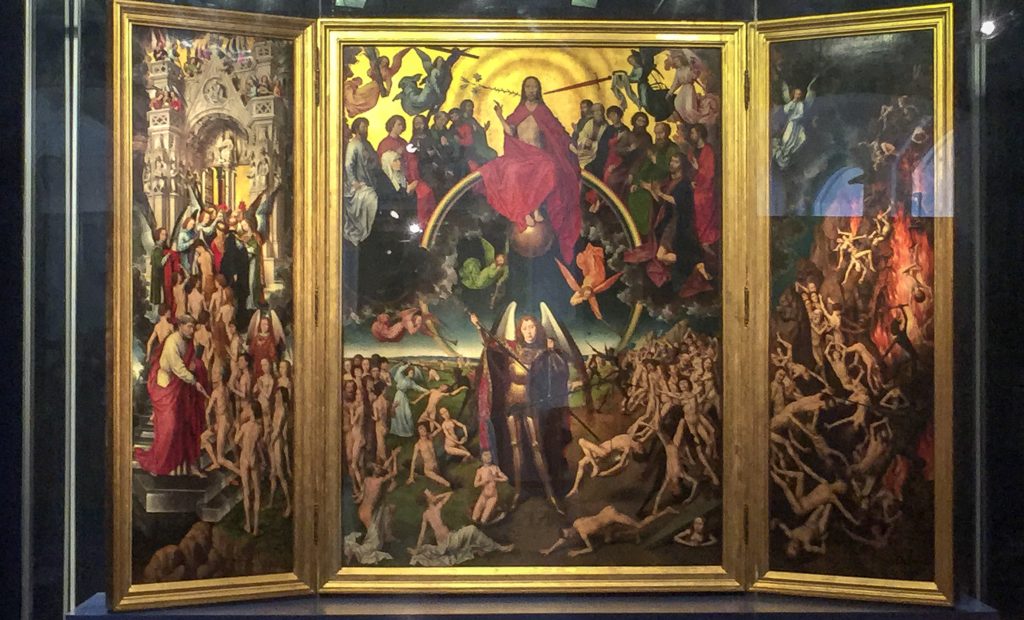
Hans Memling, “The Last Judgment”
I found one of my favorite examples of ‘art tells history’ in Gdansk, Poland. The altarpiece by Hans Memling touches on many eras and is Western European history in a nutshell:
- commissioned by the Medicis in the 1460s it never made it to Florence
- it was painted in Bruges,
- stolen en route to Florence by a Polish ship captain and transferred to Gdansk,
- coveted by Peter The Great in the early 1700s (he did not secure it),
- taken from Gdansk by Napoleon’s new director of the Louvre in the early 1800s
- transferred to Berlin when the Prussians helped defeat Napoleon in 1815
- returned to Gdansk in 1817,
- taken by the Nazi’s as they fled Poland at the end of World War II,
- found by the Soviets shortly thereafter and hung in the Hermitage,
- until returned to Gdansk in 1956 where it hangs proudly now as a national treasure.
- But doesn’t it really belong in Florence at the Uffizi with the other Medici treasures?
Protecting and Recovering Treasures
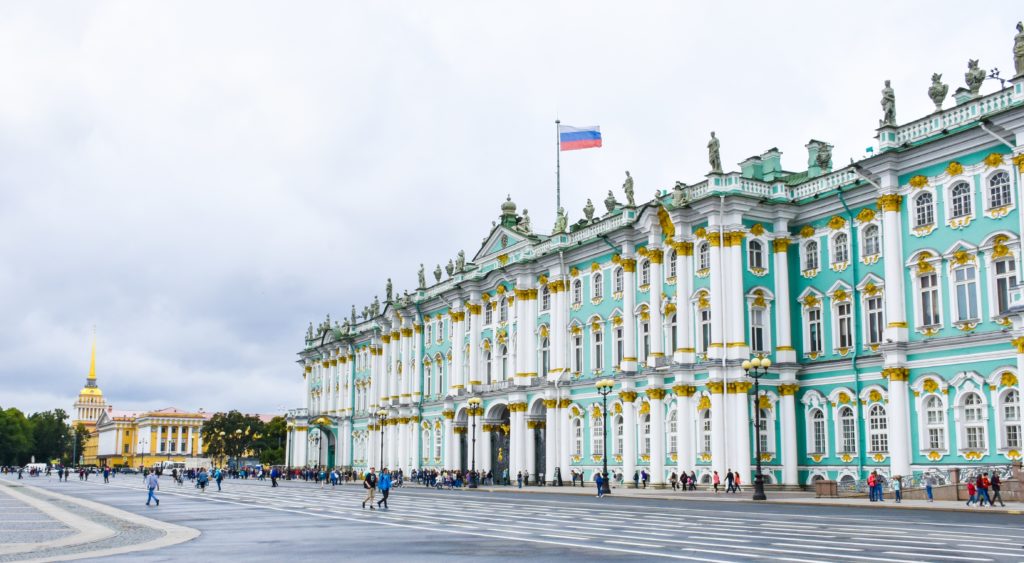
The State Hermitage Museum, St. Petersburg, Russia
Countries and individuals have always placed a priority on protecting their great treasures that define their culture, identity and yes, have great economic value. Invaders or colonizers have gone to equally extreme measures to find these pieces and take them as ‘war booty’, or in the case of colonizers, to supposedly ‘protect them’.
My earlier article “Glories of the Hermitage” tells the story of the empty frames tours during the 900 day Siege of Leningrad in Russia. Stories of the extreme measures taken to protect artworks during WWII continue to emerge.
Sales of treasures, including Crown Jewels, after revolutions in France and nearly 130 years later in Russia have spread their patrimony far and wide. One pair of Marie Antoinette’s diamond earrings are currently in the Smithsonian Institution in Washington, DC. A recent sale by Sotheby’s Geneva saw France’s royal history and many of her jewels dispersed further. The story of that auction and the history of those jewels can be found here.
The dawn of the Gilded Age saw an economic revolution, as American money purchased many of Europe’s masterpieces for their private and newly opened public collections. Over recent decades, some of the world’s treasures have found their way to the Arabian Gulf countries as oil money searches for cultural authority. China has been singularly focussed on the return of their own treasures and has not looked to the purchase of “western” masterpieces. But then focus and a long-term perspective have always made China distinct from every other country.
Restitution?
For these sales, auction houses try to establish clear provenance to obviate future ownership disputes. But many more disputes between countries continue over such iconic treasures as the Elgin Marbles, Rosetta Stone and a recent fascinating new find, the “Apollo of Gaza” (or Hamas’ Apollo).
The loan in 2014 by the British Museum of one of the disputed Elgin statues (Marbles) to the Hermitage State Museum in St. Petersburg, Russia incited much new discussion on ownership, provenance and international relations. Viewed by many as a provocative move at best, the world waits for the dialog to follow between museums, governments and the public. Here is the New York Times article on this surprising move by the British Museum.
The new Acropolis Museum overlooking the Acropolis in Athens makes its own statement with their portrayal of the missing marbles….
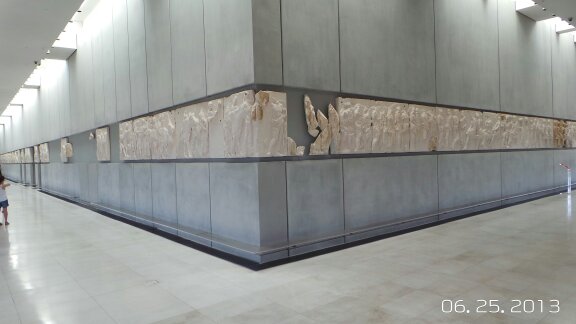
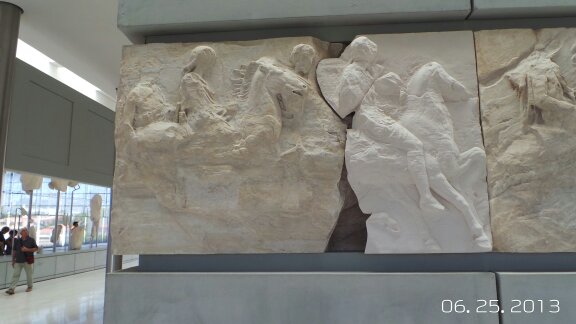

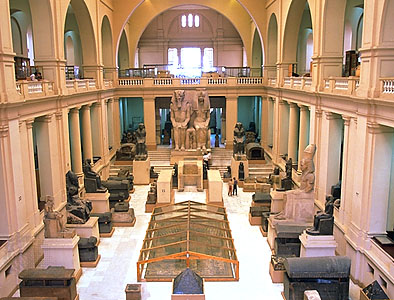
These disagreements on ownership continue to limit art that museums and countries are willing to share for exhibitions, but many disputes are also very personal.
Often, restitution is not clear cut for art, jewels or palaces. (I was recently in St. Petersburg and asked my guide if the Yusupov family had asked for the return of any of their homes or art since the fall of the Soviet Union. She said no, no family had asked for the return of anything.) Much of the Yusupov family art (a family that was wealthier than the Romanovs prior to the Russian Revolution) is in the new Storage rooms/annex of the State Hermitage Museum and a few pieces are on display during private tours.
Monuments Men
The movie Monuments Men was a hit in the US. The story is riveting and I urge all to read the book of the work of these men. But their work only found some of the treasures. Finding their rightful owners continues in fits and starts. The Monuments Men Foundation continues this work with some notable success stories of returning art to the rightful Jewish owners and museums. Their 2016 television series “Hunting Nazi Treasure” found wide acclaim for their efforts.
The legal questions of who owns, purchased or stole treasures are usually not clear cut, but with continued attention focussed on the treasures being found after WWII and the Elgin Marbles, they are again front page; for a while.
On your next museum visit, try to look behind the canvas of that painting or beyond the sparkle of that jewel and you will likely find a story with many chapters.

You make very good points, Jean – and to me, it ties in with the question if whether or not to destroy the ‘fake’ Chagall. As has been pointed out already, the case is now so well publicised that surely no collector is really going to buy it in error. And – what if, some years down the line, it turns out the experts were wrong?
Very good point Sarah. Analogous to the death penalty—-for art. And on another related topic, hoping to go see the art exhibit:
“Intent to Deceive: Fakes and Forgeries in the Art World”
http://www.artsandartists.org/exhibitions-intenttodeceive.php
Or as I like to call it “Illegitimate art”
I was at the Acropolis Museum in October and saw the poignant exhibit with the missing pieces. I really feel as if the marbles belong to Greece and hope to see them returned. It seemed like such a provocative, almost snarky, thing to loan them to Russia. They aren’t theirs under any scenario and the Greeks are allies who could use the potential economic tourism boost of having them. I suppose getting them back could have been problematic but I’m not all that trusting of Putin either! I hope Amal Clooney can get it all straightened out. After all, no one thought George Clooney would ever get married again and she made that happen in no time!